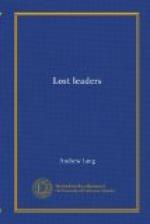and studied rendering” of events. But
many of Mr. Browne’s illustrations of Dickens
are immortal. They are closely bound up with
our earliest and latest recollections of the work
of the “incomparable Boz.” Mr. Pickwick,
we believe, was not wholly due to the fancy of Mr.
Browne, but of the unfortunate Seymour, whom death
prevented from continuing the series. Every
one has heard how Mr. Thackeray, then an unknown man,
wished to illustrate one of Mr. Dickens’s early
stories, and brought Mr. Dickens examples of his skill.
Fortunately, his offer was not accepted. Mr.
Thackeray’s pencil was the proper ally of his
pen. He saw and drew Costigan, Becky, Emmy,
Lord Steyne, as no one else could have drawn them.
But he had not beheld the creations of Boz in the same
light of imaginative vision. Sometimes, too,
it must be allowed that Mr. Thackeray drew very badly.
His “Peg of Limavaddy,” in the “Irish
Sketch Book,” is a most formless lady, and by
no means justifies the enthusiasm of her poet.
Thus the task of illustrating “Pickwick”
fell to Mr. Browne, and he carried on the conceptions
of his predecessor with extraordinary vigour.
The old vein of exaggerated caricature he inherited
from the taste of an elder generation. But making
allowance for the exaggeration, what can be better
than Mr. Pickwick sliding, or the awful punishment
of Stiggins at the hands of the long-suffering Weller?
We might wish that the young lady in fur-topped boots
was prettier, and indeed more of a lady. But
Mr. Browne never had much success, we think, in drawing
pretty faces. He tried to improve in this respect,
but either his girls had little character, or the standard
of female beauty has altered. As to this latter
change, there can be no doubt at all. Leech’s
girls are not like Thackeray’s early pictures
of women; and Mr. Du Maurier’s are sometimes
sicklied o’er with the pale cast of an aesthetic
period.
It is probable that the influence of Mr. Browne’s
art reacted in some degree on Dickens. In the
old times every one whom the author invented the artist
was pretty certain to caricature. Thus the author
may have felt the temptation to keep pace with the
frolic humour of the artist. Mr. Browne cannot
be blamed for a tendency to exaggerate noses and other
features, which was almost universal in his time.
None of us can say what conception would now be entertained
of Dickens’s characters if Mr. Browne had not
drawn them. In the later works of Dickens (when
they were illustrated) other artists were employed,
as Mr. Stone and Mr. Fildes. These are accomplished
painters of established reputation, and they of course
avoided the old system of caricature, the old forced
humour. But we doubt whether their designs are
so intimately associated with the persons in the stories
as are the designs of Mr. Browne. The later
artists had this disadvantage, that the later novels
(except “Great Expectations,” which was
not illustrated) were neither so good nor so popular




